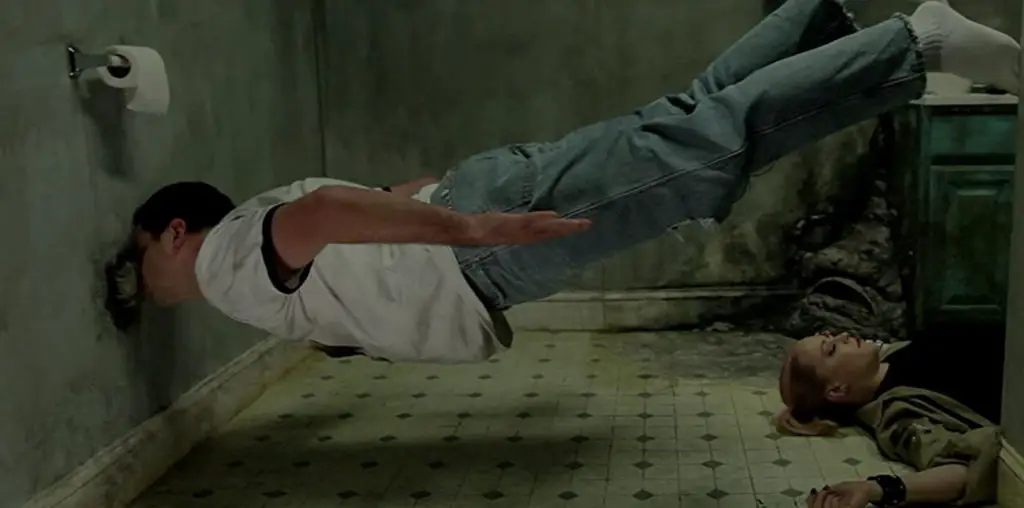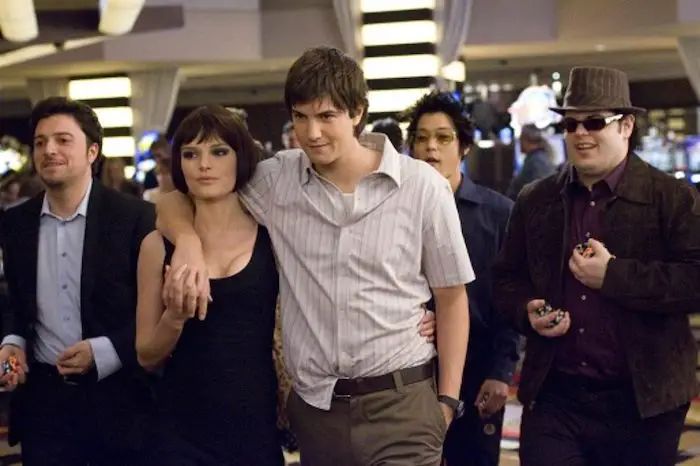
Pinky’s Last Stand ^ * ^ Directed By: Belle Verplank ^ Pinky is a Snoopy doll clothed in a pink dress. As the credits roll, Pinky drives through city streets – going too fast for her own good. A huge tumble of city lights and credits roll past. The credits end. The words “The End” appear on the screen. The film is over. I don’t laugh. I don’t see the point. I am not amused. Here ends the review.
Stradiv ^ ** ^ Directed By: Alex Dalton ^ When I was in college, not all that long ago, I remember a guy named Jon.
Jon had dropped out of college the previous semester. He lived with his girlfriend in a dorm room that he christened “The Cello Shed,” and he would occasionally give lectures on twentieth century music there.
For one reason or another, a professor on campus took a liking to Jon and invited him several times to speak to her class on twentieth century music. Whether he was paid for this I have no idea.
Twice a semester, the twentieth century music class gave concerts – performing the music they were learning about in class. One such concert lives in infamy.
Jon was the source of the infamy. During the concert, he stepped onto the stage carrying a viola. The program stated that the work in question originally was written for the violin but had been re-orchestrated by Jon for viola.
Once on the stage, Jon picked up the viola, assumed the position and prepared to play. Then, in one swift motion, Jon smashed the viola on a nearby table. The viola co-operated wonderfully, splitting into dozens of pieces and shocking the audience into a fairly lengthy discussion of what they’d just seen… and what it meant.
Which was nothing. It was meant to shock.
I felt this way about “Stradiv,” which strikes me as two films shoved together with a weak link.
The first film deals with Nicholai, who has come to America with his family heirloom in tow. This heirloom is a Stradivarius violin. For those of you who didn’t spend four years in music school, Stradivari is famous for his violins, made up until he died in 1737 and still unsurpassed in tonal quality even today.
Nicholai relates how the violin was given to him by his grandfather, who claimed his grandmother’s soul lives in the violin. Nicholai has come to the United States so he can give children violin lessons.
In a short musical montage, Nicholai plays his violin on the beach and acquires his first student.
He starts to teach his student, and then… something horrible happens.
I am loath to reveal what happens because I don’t know that it matters. Suffice to say, I felt the way I felt when Jon shattered a viola on stage – initially it was quite exciting, interesting, even, but it felt empty afterwards.
What was the point? The start of the film seems to indicate that perhaps I should be questioning how fragile life is, or contemplating the horrors that are caused through everyday anger and carelessness, but mostly I felt tricked.
The film starts out as though it might be about the legacy of heritage or the transforming power of music, but jerks the viewer in an unexpected and pointless direction. Much like the destruction of the viola, you can assign a point to shock value when there really isn’t one.
Straighten Up America! ^ 1/2* ^ Directed By: Brennan Howard ^ ’d like to think this film might have deserved a higher rating had it not claimed to be a documentary at the head of the film.
But that would be wrong.
This film sets out to do two things – first, to show that trying to convert a gay person into a straight one is dumb.
Secondly, it tries to be funny.
It fails miserably, on both counts.
Straighten Up, America, is supposed to be a religious group that works with gays to turn them straight. Their leader is Nate, a janitor who, on company time, holds meetings in the office building he’s supposed to be cleaning.
This is supposed to be funny. It isn’t.
They sell “Lookies,” the “Lord’s Cookies,” in an effort to raise money.
This is supposed to be funny. It isn’t.
Nate is a huge jerk, who ends up getting beaten up by his janitor co-workers, mocked by his flock and rejected by his former sponsors.
This is supposed to be funny. Say it with me – it isn’t.
At twenty minutes, this film is twenty minutes too long. It is agony to sit through, and when the film ended with “To Be Continued,” I felt genuinely threatened.
As for the point it was trying to make, well, Bob Odenkirk and David Cross of “Mr. Show” beat them to it by about seven years. Oh – and they managed to be funny.
My Interview With Spike Jonze ^ **** ^ Directed By: Jonah Kaplan ^ I don’t know whether this film is a joke or not. I’ve watched it twice now, all the way through, and I don’t know if what happened really happened, or if it’s an elaborate prank on the viewer, or perhaps an elaborate prank on Spike Jonze.
It doesn’t matter though. Either way it’s pretty funny.
In the film, Jonah Kaplan is both the director and the interviewer. He is told, via a phone message, to show up at an appointed time and place to interview Spike Jonze, director of “Adaptation” and producer of “Jackass.”
Jonah shows up, and against the advice of the camera operator brought in to film the interview, takes the camera himself. He doesn’t know how to operate it, however, and therein lies the humor of the film.
Kaplan continually captures the wrong half of the interview – he tapes his questions, then turns the camera off when Jonze gives his answers. He confuses Jonze with other directors, most amusingly Spike Lee. When he realizes his mistakes and attempts to rectify them, the battery on the camera dies.
Was it a real interview? I highly doubt it – I doubt it would have seen the light of day if that were the case. No, the whole thing is more than likely a joke, the kind Jonze is known for. Uncomfortable enough to be real, funny enough to be not.
Either way, it’s a great little film.
Mace Windu Theater: “Getting Medieval” ^ *** 1/2 ^ Directed By: Evan Mather ^ I imagine almost any fan of “Star Wars” and “Pulp Fiction” has thought, at one time or another, that something like this would be pretty funny.
And it is.
Using “Star Wars” action figures, Mather recreates the Jedi council of Episode 1. Only this time around, Mace gives Sam Jackson’s most celebrated speech from “Pulp Fiction.”
It’s a very short, well-animated, amusing little film. And while it may be a single joke, the joke is funny enough to make it worth seeing.
Extreme Man and Insane Boy, Episode 1, “The Screaming Skull” ^ *** ^ Directed By: Webster Colcord ^ “Extreme Man and Insane Boy” strikes me as one of those films made for a Web site, or perhaps the now long-lost MTV staple “Liquid Television.” Fully half the film is an extended credits sequence, sans credits, as Extreme Man and Insane Boy run, and jump, and fly a car around.
Once that sequence ends, the “full” title pops up, informing us this is Episode 1. It involves, well, a guy named The Screaming Skull, who wants to create an army of the living dead.
Extreme Man and Insane Boy find out about this nefarious plot and race off to thwart it, using footage last seen minutes ago in the opening sequence.
“Extreme Man and Insane Boy” could be an amusing cartoon, but it quickly grows tiresome. Since the plotted portion of it only runs about three minutes, there isn’t much character development or room for surprises, twists and turns. It’s well animated, to be sure, and occasionally amusing, but there’s nothing here to intrigue me into hoping for Episode 2.
Buena Vista Fight Club ^ ** ^ Directed By: Evan Mather ^ How do you judge a film with no actors, no plot and no real point? I guess it might have a point, as the notes with the film state:
“Set within the contents of a glossy furniture catalog, a trio of musicians go on a bloody rampage.”
Yes, it’s set in a catalogue, and yes, there is a bloody rampage. It’s pretty impressively animated, seeing as how the film states proudly at the end that it was “made with a Mac.”
I guess that’s something of an accomplishment, but mostly the film just annoyed me. It’s a joke title and a joke film, and neither elicited a chuckle from me.
Feyd “Tear Us” ^ *** 1/2 ^ Directed By: Maximillian Graenitz ^ Not exactly a film, more of a music video, and billed as a promo, this is an interesting clip designed around a song by Feyd.
This film doesn’t attempt to tell a story, and it doesn’t attempt to follow the lyrics of the song. Instead it tries to capture a mood of isolation, and does it nicely.
There’s little else to say about the film – it’s bleak, and moody, and evokes a feeling of solitude and anxiety. It looks low-grade, but it’s supposed to, and therefore has accomplished what it set out to do.
Nice work.

